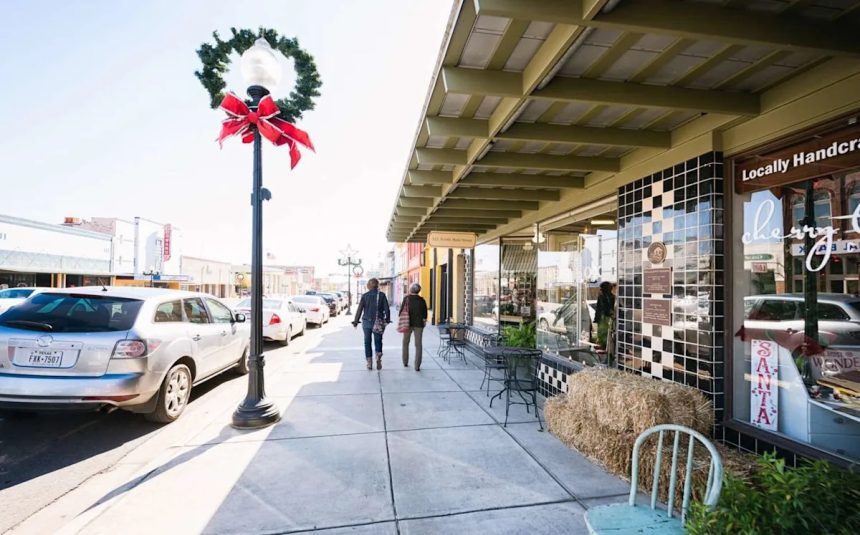The battle between progress and preservation has waged on in Texas for nearly 200 years. The push and pull, and ultimate acquiescence, over keeping up with the times is clearly evidenced by the state’s slow adoption of railroads decades past and eventual highway system boom. But the inherent love of the state’s history, oft tattooed on the hearts of Texans, is clearly evidenced by the sudden rise of once forgotten railroad boomtowns.
As with many things, Texas was slow to the railroad boom for reasons similar to political positions today – fears of capitalistic overpowering and federal oversight created large waves of pushback.
Because of this, it took the federal government gaining control of the railroad commission and a rise in populism in the 1890s before the state seriously began connecting its eastern and western borders with train tracks, according to Todd Barnett, a Trinity University history professor.
Before this, railroads were short and mostly funded by wealthy Texans looking to connect their farms or commercially used properties to coasts or areas of high trade, unfortunately often linked to human trade before slavery was abolished. But once the railroad boom finally struck the Lone Star State, it made fast cities out of what were once rural outposts.
“That brings Texas together and allows for a much greater degree of connecting east and west,” Barnett told MySA. “Before this, almost all of the population centers were mostly to the east. They were around rivers, and they were around the coast.”
A view of train tracks near 1604 and Tradesman on Thursday, June 1, 2017. County Judge Nelson Wolff is thinking about a passenger rail line going from The Rim to Martin St. at Interstate 35, using existing freight line tracks owned by Union Pacific. (Kin Man Hui/San Antonio Express-News) (Kin Man Hui /San Antonio Express-News)
Having quicker means of travel across Texas, and the tapping of aquifers, the state became inhabitable even where streams and large bodies of water were distant. So, towns like Taylor, Poteet, Abilene, The Grove, Yoakum and Fowlerton saw sudden population spikes, and main streets quickly erected with towering turn-of-the-century architecture.
But it was all relatively short-lived. Just a handful of decades later, cars were becoming the new normal, and the country set its sights on highways. If that highway didn’t run through town, it typically spelled the city’s death or decline.
“In my view, small towns, [which] at some point were the destination for business and travel along the railways, have missed the economic growth other towns along the highways have experienced. The major shift in transportation mode from using trains in the 19th and early 20th centuries to personal and commercial vehicles has made highway towns expand and grow exponentially,” Samer Dessouky, UTSA professor and assistant director of environmental engineering and construction management, told MySA.
Both professors were clear: When highways came in, they often either killed these towns or completely reshaped them. City hubs and downtowns shifted from where the tracks were laid toward the new flashy highways. Barnett pointed to San Marcos and Seguin as strong examples of this, where the historic downtowns anchored by defunct train tracks are struggling, and the booming new commercial districts along the highway loom in the distance.
While many of these railroad boomtowns may not sound familiar – Yoakum and The Grove are essentially ghost towns now lost to time – some are seeing a resurgence in a post-COVID world where folks are looking to explore their neighboring towns.

Upscale developments continue to crop up around Taylor, Texas, as a slow burn population boom continues. (Zachary-Taylor Wright/MySA)
“I introduce myself to everybody, especially people that I don’t recognize,” 32-year-old Taylor dweller David Blake told MySA while sitting at his go-to coffee spot, Ripple and Rose Café, back when we visited the town on the rise in June. “Taylor is such a – it’s growing every day – but it’s small enough that you see everybody in town at Walmart or H-E-B. And I refuse to have anybody say, ‘Well, you’re rude.’ So, I introduce myself.”
If you ask the Greater Taylor Chamber of Commerce president, Tia Rae Stone, she says the town started at the brink of technology with the railroad and is booming again for the same reason. Major tech companies, like Samsung, are investing billions into the area with manufacturing and production plants.
Poteet, too, is poised for a comeback. San Antonio’s Southside is rapidly expanding, barreling straight for the likes of Poteet and Somerset, which the train tracks of yesteryear once graced. Plus, massive manufacturing companies, like JCB and Toyota, are bringing jobs to the region, creating a need for housing nearby. There are even some up-and-coming cool dining spots cropping up (and the owner says investors are quietly snatching real estate), suggesting it’s a city on the rise.

Backyard Kitchen started as a tiny room on a big plot of land with a grill and a dream. Since then, the Stelzig family has continued to build, by themselves, a sprawling outdoor and indoor dining experience. (Zachary-Taylor Wright/MySA)
However, Dessouky’s prognosis is a little more dire, if not pragmatic, for some of the other towns derailed by the highway system.
“Unless a strategic planning for the highways to pass through these towns, they will not have the same growth they experienced in the past, as more people are seeking jobs, education, housing and urban living,” he said. “Transportation in our modern understanding is accessibility to highways and ports. Railways have for the most part been cornered to serve the agricultural trade, which is not the most contributing to GDP growth.”
This article originally published at Texas railroad towns derailed by highways are finding new routes.









